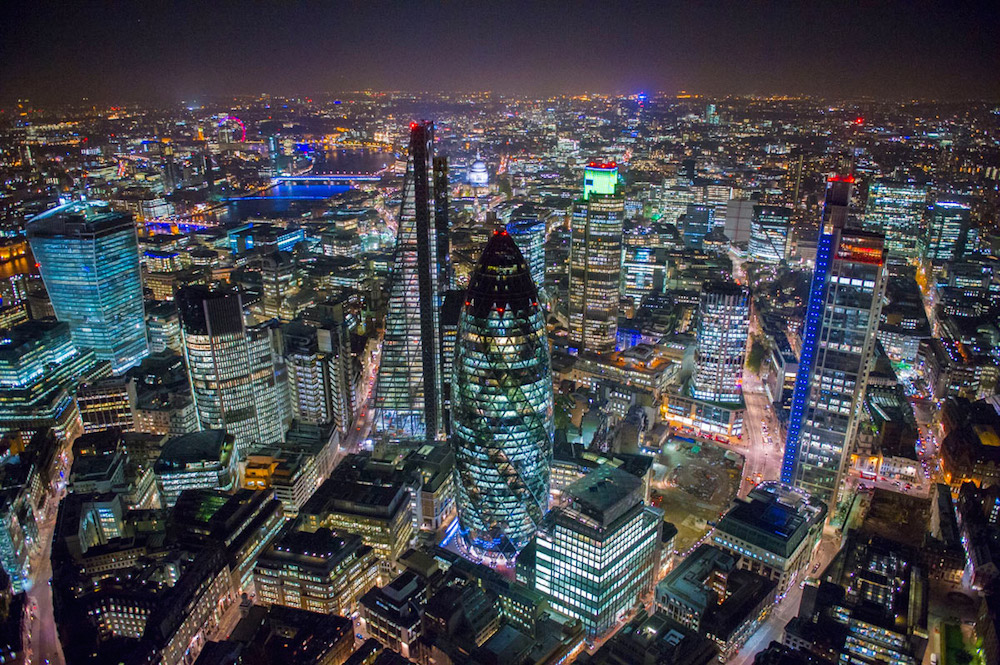Report suggests UK capital is twice as pricey as Sydney and four times more than Rio for companies to place staff.
- The Guardian, Tuesday 23 September 2014
London’s ascendency to first place was put down to big increases in office rents and the pound’s strength against the dollar. Photograph: Jason Hawkes/Barcroft Media
London has overtaken Hong Kong as the world’s most expensive city to live and work in, with a new study suggesting it is almost twice as pricey as Sydney, and four times more than Rio de Janeiro.
The estate agent Savills said that in London, rising rents and the strong pound had pushed up the typical cost per individual employee of renting somewhere to live and leasing office space to $120,000 (£73,800) a year.
That puts the UK capital well ahead of other global hubs such as New York and Paris which, aside from Hong Kong, are the only other locations where the combined annual costs of renting residential and office space top $100,000 per employee.
London’s rise to first place in the rankings was blamed in part on its soaring property prices, which have jumped by 18.4% in the past year, according to Savills. Office rents have also risen significantly. In its most recent quarterly report on the commercial property sector, the rival estate agent Knight Frank said that over the previous 12 months, prime office rents had risen by 9% in the City and by 8% in the West End area. Someone with €100m to spend would be able to buy just 2,700 square metres of prime office space in the West End, but would get 17,000 square metres or more for their money in Berlin or Amsterdam.
The pound’s strength against the dollar has made the situation worse.
According to the Savills study, London’s overall real estate costs grew in US dollar terms by an annualised rate of 10.6% in the first six months of the year, making the it “the world’s most expensive city for companies to locate employees”. That in turn prompted Savills to warn that it risks becoming less competitive as a result.
“For example, the availability of low-cost office space in and around Silicon roundabout, coupled with affordable residential accommodation, helped put the capital on the technology map. But gentrification has priced out new startups, and the vitality of central London locations are at risk as they become too expensive for the types of occupiers that made them attractive in the first place,” the report said.
By contrast, falling residential rents and a weakening currency contributed to Hong Kong, which had previously topped the table for five years running, dropping to second place.
Savills’ 12 Cities report is designed to help companies assess the costs of relocating employees. It measures the total cost per employee in US dollars of renting living and working space in some of the world’s global hubs. The calculations are based on the cost of two seven-strong staff teams that are representative of start-up businesses, one based in a “prime financial sector location” and the other in a slightly less prime or creative area, in order to give a representative figure.
The annual per person cost of renting somewhere to live is also factored in, on the basis that employers are interested in these costs because upward pressure on wages may be stronger in areas where the cost of accommodation is high.
The annual cost per employee in London was put at $120,568, with Hong Kong close behind at $115,717. New York and Paris were in third and fourth place, at $107,782 and $105,550 respectively. Sydney came eighth at $63,630, Shanghai tenth at $43,171 and Rio eleventh at $32,179. Mumbai was bottom of the table at $29,742.
“Despite its climb in the rankings from fifth to first place since 2008, London is still a way off the live/work accommodation costs record, set by Hong Kong in 2011 at $128,000 a year,” Savills said, adding that Hong Kong was still “by far the most expensive city” in which to buy residential property, with prices 40% higher than London – although the gap was narrowing.
“Comparatively affordable” Rio and Sydney had seen significant increases in live/work costs since 2008 – up 85% and 58% respectively – but Savills said Rio still looked “highly competitive”.
Yolande Barnes, the company’s director of world research, said: “This year has seen much more modest real estate price growth in nearly all our world cities, and some have shown small falls. We expect this subdued trend to continue as investor interest and market activity shifts to second-tier cities.
“This lower level of price growth means that currency fluctuations have produced some of the biggest changes in our rankings, which are expressed in dollar terms. For multinationals looking at their local costs, it is this which is likely to exercise them more than property markets over the next year.”







































